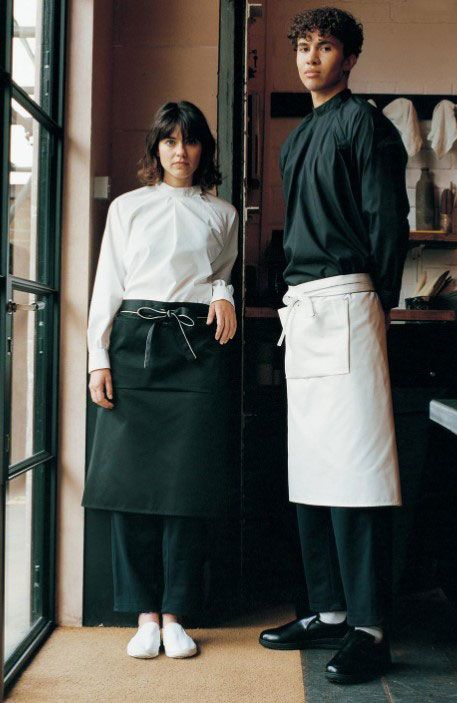
Color Trends in Modern Hospitality Uniform Design: Middle Eastern & KSA Perspectives 2025
As Saudi Arabia and the broader Middle East redefine global luxury hospitality standards under initiatives like Vision 2030, the strategic use of color in staff uniforms has become a sophisticated art form. The 2025 landscape reveals a nuanced approach, blending global design currents with deep cultural resonance to create attire that not only looks impeccable but also enhances brand narratives and elevates the guest experience.
The Strategic Imperative of Color in Hospitality Branding
Color in hospitality uniforms is a powerful, non-verbal communicator, influencing perceptions and emotions:
- Brand Identity & Recall: Signature color palettes can increase brand recognition by up to 80% (Source: Color Marketing Group, 2024).
- Guest Mood & Behavior: Thoughtfully chosen colors can impact guest relaxation, perceived service speed, and even F&B spending.
- Cultural Connection: Colors that resonate with local heritage can deepen guest engagement, particularly important in KSA's culturally rich environment.
- Perceived Luxury & Quality: Specific hues and combinations are intrinsically linked with premium experiences.
- Staff Role Differentiation: Effective color-coding improves operational flow and guest navigation.
KSA Hospitality Color Impact Study 2025
- Hotels with culturally resonant uniform colors reported a 15% increase in positive guest feedback related to ambiance.
- Use of specific "luxury" hues (e.g., deep blues, rich golds) correlated with a 10% higher perceived value by guests.
- Staff in uniforms with psychologically "calming" colors reported 12% lower stress levels during peak hours.
Dominant Color Trends for 2025 in Middle Eastern Hospitality
The current color landscape is characterized by sophistication, authenticity, and a nod to the region's unique identity:
1. Nuanced Naturals & Desert Hues
Reflecting the stunning Arabian landscapes, palettes of warm sands, soft terracottas, muted stone greys, and deep oasis greens are prominent. These create a sense of tranquility and organic luxury.
- Application: Often used as base colors for core uniform garments, providing a sophisticated canvas.
- Psychological Impact: Grounding, serene, authentic, and understated elegance.
- KSA Relevance: Directly connects to the Kingdom's diverse natural beauty, from desert dunes to ancient rock formations.
2. Jewel Tones Reimagined
The traditional opulence of jewel tones (sapphire, emerald, ruby, amethyst) is being modernized with desaturated or "dusty" variations. This offers richness without ostentation.
- Application: Accent pieces, linings, bespoke accessories, or for specific high-impact roles like guest relations managers or sommelier.
- Psychological Impact: Luxurious, exclusive, cultured, and memorable.
- Cultural Link: Evokes the heritage of Arabian craftsmanship in jewelry and textiles.
3. Monochromatic & Tonal Layering
Sophisticated use of varying shades, tints, and textures of a single color family (e.g., charcoals with lighter greys, or deep indigos with softer blues) creates a refined, contemporary aesthetic.
- Application: Complete ensembles, differentiating roles through subtle tonal shifts or fabric texture variations.
- Psychological Impact: Elegant, modern, cohesive, and calming.
- Design Focus: Highlights tailoring, fabric quality, and silhouette.
4. Warm Metallics & Burnished Accents
Rose gold, brushed bronze, and antique copper are supplanting brighter golds and silvers for a more understated luxury. These are used for buttons, embroidery, and subtle trim.
- Application: Hardware, subtle logo details, piping, or thread in woven fabrics.
- Psychological Impact: Warm, sophisticated, premium, and timeless.
- Trend Note: Reflects a broader shift in luxury design towards more subtle indicators of quality.
5. Biophilic Greens & Blues
Inspired by nature and well-being, shades of sage, olive, teal, and deep ocean blue are increasingly popular, especially in wellness-focused resorts or properties emphasizing sustainability.
- Application: Spa uniforms, resort wear, or as calming accents in main hotel areas.
- Psychological Impact: Restorative, tranquil, fresh, and connected to nature.
- Vision 2030 Link: Aligns with KSA's focus on eco-tourism and wellness destinations.
Integrating Color with Brand Narrative and Environment
Effective color strategy goes beyond trends; it's about storytelling:
- Environmental Harmony: Uniform colors should complement the hotel's interior design and natural surroundings. A Red Sea resort might use coral and turquoise, while a Riyadh city hotel might opt for sophisticated urban tones.
- Brand Storytelling: Colors can articulate a brand's unique narrative – e.g., historical legacy (deep, heritage colors), modern innovation (clean, minimalist palettes), or local authenticity (earthy, regional tones).
- Target Audience Resonance: Understanding the color preferences and associations of the hotel's key guest demographics.
Practical & Cultural Considerations in KSA
- Climate Adaptability: Lighter colors are often favored for heat reflection, but advanced cooling fabrics now allow for darker, richer colors without compromising comfort.
- Maintenance & Durability: Colors must be robust enough to withstand industrial laundering and resist fading from sun exposure. Dye quality and fabric choice are crucial.
- Cultural Significance: Deep understanding of local color symbolism is vital. For instance, green holds special significance in Saudi culture. White is associated with purity and is common in traditional attire.
- Modesty & Professionalism: Color choices must support a look of dignity and respect, aligning with Saudi cultural values for both male and female staff.
The Future of Color in Middle Eastern Hospitality
- Personalized Palettes: AI-driven tools may help create hyper-personalized color schemes for niche hotel brands.
- Sustainable & Ethical Dyes: Increased demand for plant-based and low-impact dyeing processes.
- Interactive Colors: Textiles with subtle color-shifting properties responsive to light or temperature (still emerging).
- Digital Twin Prototyping: Using VR/AR to visualize uniform colors in the actual hotel environment before production.
Conclusion: Chromatic Strategy as a Competitive Edge
In the dynamic and rapidly expanding hospitality landscape of Saudi Arabia and the Middle East, color in uniform design is a powerful strategic tool. The 2025 trends reflect a sophisticated fusion of global aesthetics, regional heritage, and psychological insight. By thoughtfully curating their uniform color palettes, hospitality establishments can significantly enhance their brand positioning, elevate the guest experience, and create a visually harmonious environment that resonates with luxury, authenticity, and service excellence. This strategic approach to color is no longer a finishing touch but a foundational element of success in the region's competitive market.
About the Author

Layla Karim
Layla Karim is a renowned Hospitality Design and Branding Strategist with 15+ years of experience in the MENA region. She specializes in leveraging color psychology and cultural insights to create impactful uniform programs for luxury hotels and resorts, aligning attire with brand narratives and guest experience goals.
Craft Your Signature Hospitality Palette
Let UniformSA's experts guide you in selecting a uniform color strategy that defines your brand, captivates guests, and reflects the unique essence of your Middle Eastern hospitality establishment.
Request a Color Consultation